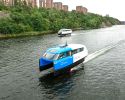OECD: Port of Gothenburg in need of investments

The International Transport Forum released in January a new study on the impact of mega-ships on the port of Gothenburg, Sweden's largest port. Gothenburg handles 57% of the country's container traffic and is thus a critical asset for both the region and national economy.
The report notes that the most important challenge for Gothenburg is to remain attractive for direct calls from ocean-going vessels. In practice, this means attracting the new container mega-ships serving the Asia-North Europe trade lane, as Asia is Sweden's main export market for containerised goods.
Thanks in part to container terminal upgrades, Gothenburg has been successful in attracting some of these direct calls. Because of constraints to the depth of the port access channel and container berths, many ship types cannot call Gothenburg when fully loaded, in some cases not even half loaded. While this is not a major problem for the moment, the increasing average ship size caused by mega-ships and the cascading effect they have on all trade lanes, will at some point require deepening the access channel and berths to maintain Gothenburg's strong position.
Against this background the report makes three main recommendations:
- Develop a focused national ports policy for Sweden: Such a ports policy would include a clear articulation of the roles each port is expected to fulfil for the Swedish economy, as well as in which sector and in particular the container sector. A common understanding should be developed between local, regional and national governments, so that a national focus will not be undermined by local planning permits for port expansions. Within this national ports policy, the need for Swedish shippers to have at least one container port with direct calls from its main trade partners, in particular from Asia, should be recognised. As such, Gothenburg should be acknowledged as a strategic gateway for trade and freight for the whole country.
- Make it easier for the port of Gothenburg to attract direct calls by container ships: This should include developing a proactive approach to deepen the fairway and container berths and translating this priority into clear public investment decisions, e.g. with respect to improving maritime access, hinterland connectivity, dry port development and short sea shipping.
- Resolve bottlenecks related to mega-ships: The handling of mega-ships would be accommodated by facilitating longer trains and by resolving remaining bottlenecks in the railway network. In order to increase utilisation of infrastructure, projects to increase containerisation of main export products such as forestry products could be stimulated. The study was carried out as part of a programme on the impact of mega-ships at the International Transport Forum (ITF). It was made possible through a voluntary contribution by the Port of Gothenburg.
Related content:
-
 NextWave – en podd som ska locka unga
NextWave – en podd som ska locka unga -
 Ny studie: Eldrivna pendelbåtar kan effektivisera Stockholms kollektivtrafik
Ny studie: Eldrivna pendelbåtar kan effektivisera Stockholms kollektivtrafik -
 Sjöfartens utsläpp ökar
Sjöfartens utsläpp ökar -
 Sociala relationer påverkar val av bränsle
Sociala relationer påverkar val av bränsle -
 Sjöfartens omställning kräver ”mjukare” påtryckningar
Sjöfartens omställning kräver ”mjukare” påtryckningar -
 Hon hade avtalad tid med Kapten ynkrygg
Hon hade avtalad tid med Kapten ynkrygg -
 Lighthouse omvärldsanalys 2025 – osäkerhet och tullar präglar sjöfarten
Lighthouse omvärldsanalys 2025 – osäkerhet och tullar präglar sjöfarten -
 Se seminariet Shipping in the Marine Environment
Se seminariet Shipping in the Marine Environment -
 Vad betyder egentligen de 90 procenten?
Vad betyder egentligen de 90 procenten? -
 Hålla där...
Hålla där...

